Aiming at the technical realization of multi-parameter monitoring and health monitoring of vital signs in hyperbaric oxygen chamber, a wireless sensor detection technology system solution based on IEEE802.15.4 protocol is proposed, and the architecture of wireless sensor detection system is expounded. And the hardware design method of the main control node and the vital sign parameter acquisition sensor node, the software system architecture, the software design flow and the monitoring software working interface are given. The MAC layer frame structure, the physical layer frame structure and the system time synchronization strategy are carried out. Detailed analysis and design. The prototype of the system has entered the clinical experimental stage. The clinical test data of the patient is also given in the paper, and the test data of the practical imported monitoring equipment are compared to verify the feasibility of clinical application.
With the development of technologies such as wireless communication networks and sensors, medical monitoring technologies and methods will undergo fundamental changes. Hyperbaric oxygen chamber has been widely used in clinical disease treatment. The cabin physiological monitoring system is an important device for monitoring the physiological indicators of critically ill patients during hyperbaric oxygen therapy. Due to the special environment in the hyperbaric oxygen chamber, the existing monitoring equipment has limitations on the monitoring of parameters such as ECG, blood pressure, respiration, pulse and oxygen saturation of the patient in the cabin. The main manifestations are: 1 more sensors are wired The method is connected with the processor; 2 lacks system integration between the independent sensors; 3 does not support continuous acquisition of signals and real-time processing of data; 4 wireless communication resources cannot be shared between the respective monitoring devices. Develop a wearable multi-parameter monitoring device based on wireless sensing technology, which can better adapt to the special environment of hyperbaric oxygen chamber and the needs of clinical treatment. The monitor requires electrocardiogram, blood pressure, blood oxygen saturation, pulse, respiration, body temperature detection and other circuit modules to adopt ultra-low-power devices, combined with hard and software power-saving design, so that the monitoring terminal in the oxygen chamber can be powered by batteries; After the signal acquisition and conversion, on the one hand, it is displayed on the cabin monitoring terminal (slave), and the collected signal is sent to the outboard central monitoring PC terminal (host) through Zigbee and other wireless transmission technologies to realize synchronous monitoring inside and outside the cabin.
1 system architecture and hardware design
Small package, low power consumption, wireless communication, security and interoperability are the basic requirements for the design of medical wearable monitoring devices. The system structure of the vital sign monitoring device designed in this paper is shown in Figure 1. The system is mainly composed of the monitoring PC host, the coordinator node (coor-dinatornode) and the multi-parameter acquisition sensor subnodes (sensornodes) in the cabin. The master node and each sub-node pass the IEEE802.15.4 wireless. The communication protocol constitutes a star-shaped wireless communication network with simple structure, stable operation and reliable operation.
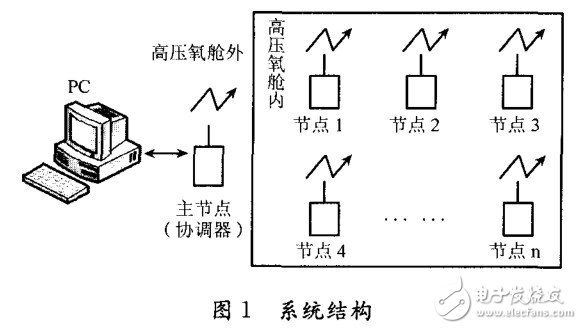
The main node is mainly responsible for coordinating the data communication between the wireless medical sensor sub-nodes in the hyperbaric oxygen chamber and the outboard monitoring host PC, and providing a transparent communication interface. The main functions of the wireless communication interface include network configuration and network management. The network configuration phase mainly completes the registration and initialization of the sensor nodes to determine the attribution, number and sampling frequency of the sensor nodes. After the network configuration is completed, the master node is responsible for the maintenance and management of the wireless network, including channel sharing, time synchronization, data extraction, data fusion and processing. The child nodes are responsible for the collection, detection and monitoring of physiological signals such as electrocardiogram, blood pressure, respiration, blood oxygen, body temperature, etc., and transmit to the master node through the wireless interface, and then the monitoring host stores and processes the collected data, and the host can perform the monitoring requirements. Status real-time display and abnormal status alarms.
1.1 master node hardware design
The structure of the master node is shown in Figure 2. It interacts with the PC host through the serial port, communicates with the sub-nodes in the cabin through the wireless module, and manages and coordinates the working sequence and synchronization of each node in the cabin. Among them, the microprocessor uses TI's ultra-low power MSP430F149, the wireless communication module uses Chipcon's 2.4GHz band RF low-power interface chip CC2420, and the power module adopts DC/DC power conversion mode. The MSP430 microcontroller integrates RAM and flash memory based on a 16-bit RISC core. It also integrates eight A/D conversion modules, a serial port module with programmable transmission speed, and a flexible clock subsystem to support multiple low-power operation modes. . The CC2420 chip is compatible with the IEEE802.15.4 protocol, with a maximum data rate of 250Kbit/s, programmable output power, and support for error correction and encryption. The MSP430 can control the CC2420 through the SPI interface and interrupt digital I/O lines, as shown in Figure 3.
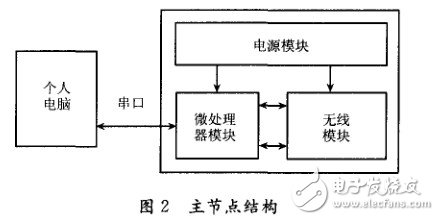
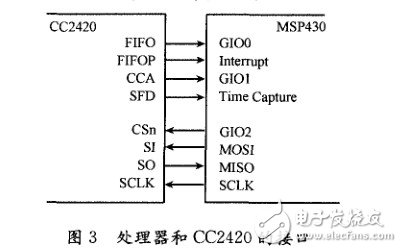
1.2 child node hardware design
The block diagram of the sensor sub-node is shown in Figure 4. It includes the power module, ECG and respiratory monitoring module, blood pressure monitoring module, blood oxygen saturation and pulse monitoring module, body temperature monitoring module, wireless transmission node, microprocessor module, input. Eight sub-modules, such as LCD display module, mainly perform acquisition, amplification, filtering and wireless transmission of vital sign parameters. Before wireless transmission, the child nodes also perform signal preprocessing such as real-time analysis and feature extraction.
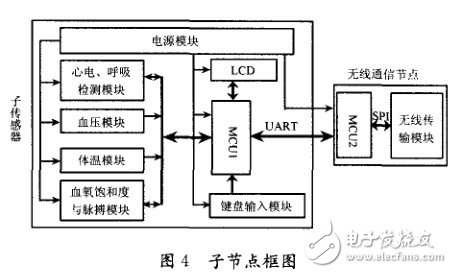
ECG detection uses a three-electrode chest detection method, using the AD620 with high input impedance, low noise, low drift precision operational amplifier as the first stage amplifier, and shared with the breathing detection circuit. After the ECG signal is processed by amplification, filtering, etc., A/D conversion is performed for the ECG waveform display; the other signal is sent to a low Q bandpass filter with a center frequency of 9-18 Hz to extract the R wave and The partial interference is suppressed, and the heart rate signal can be obtained after the waveform is transformed.
Respiratory detection uses impedance method. In order to reduce the interference of electrode contact impedance on the detection result, the two-electrode impedance method is usually selected. The PWM integrated with the controller MSP430 is used to generate two 62.5 kHz square waves with different phase difference. Modulation, the amplified signal is amplified, demodulated and filtered to obtain a respiratory signal.
The blood pressure test uses a non-invasive cuff indirect method to simultaneously detect three blood pressure indexes: systolic blood pressure (SP), mean pressure (MP), and diastolic blood pressure (DP). The measurement range is 0 to 250 mmHg (0 to 33.33 kPa).
Blood oxygen saturation detection uses fingertip pulse photodetection. According to Lambert-BeerSlaw, the transmitted light intensity of a monochromatic light transmitted through a homogeneous solution is related to the solution parameters. When the reduced hemoglobin is combined with oxygen, the absorption coefficient of the color light of a certain wavelength will change greatly. Therefore, in the case where the incident light intensity is constant, the change in transmitted light intensity reflects the change in blood oxygen saturation. At design time, we use the MSP430's clock control port to generate logic timing to control the red and infrared photodiode operation, and measure the oxygen saturation by detecting the transmitted light intensity. The body temperature measurement adopts the high-precision integrated temperature sensor DS1624 produced by American DALLAS Company. It has high resolution (up to 0.03 °C), simple peripheral circuit and direct output digital signal.
Two microprocessor modules use two MSP43OF149 chips, one for control of each parameter acquisition module and LCD display; the other is used for control of the wireless communication module, and forms a wireless communication node with the chip CC2420.
In addition, in order to reduce the size and power consumption of the equipment, the terminal terminal adopts a monochrome ultra-low working voltage LCD screen to display the physiological parameter waveforms such as electrocardiogram and pulse in real time. The terminal design is powered by a lithium battery and operates at +3.3V.
As hand belders, customes have many choices, they can buy only hand stick blenders, Hand Blenders 2 In 1 or full set Hand Blenders 4 In 1. Regarding hand Stick Blender, you can choose plastic stick or stainless steel stick.
Description for Hand Stick Blenders
200W/250W/300W low noise
One or two speeds control
Anti-slip leather handle
Plastic stick or stainless steel optional
Carton box:46*34*37cm 24pcs/ctn
20'GP: 13200pcs 40'HQ: 31368pcs
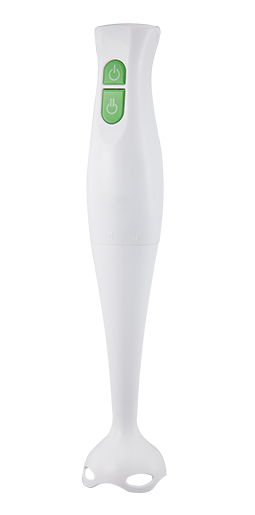
Hand Stick Blenders
Hand Stick Blenders,Hand Held Blender,Electric Stick Blender,Immersion Blender
Flying Electronic Co., Ltd , https://www.flyingelectronic.com